Michigan Tailgate Tries for Zero Waste

This is not Martavious Odoms of the University of Michigan football team preparing to catch a winning touchdown pass from Tate Forcier. It's Alexi Ernstoff, who's preparing to "take the snap" from an UM alum who's got a plate piled with refuse headed her direction. (Photo by the writer.)
In Ann Arbor on Saturday, the visiting Hoosiers came up three points shy in a homecoming game against the University of Michigan football team. Final score: 36-33.
And at a pre-game tailgate hosted by the UM Alumni Association, a team of Student Sustainability Initiative (SSI) volunteers came up at least three coffee creamer containers shy of their goal: a “zero waste” tailgate.
Those three coffee creamer containers came from Edward J. Vander Velde – from the 50th reunion class of 1959 – who kidded the volunteers who were staffing one of the waste stations inside Oosterbaan Fieldhouse, saying, “We’re still short of perfect!”
The coffee creamers weren’t the only items that still wound up in the trash instead of the compost bins, or the paper containers, or the bottle receptacles.
But according to SSI board member Greg Buzzell, who’s studying at UM’s Erb Institute, early post-tailgate estimates are that the zero-waste effort diverted about 500 pounds of material from the landfill to the compost pile, and that the tailgate generated “really very minimal” trash.

Left is Alex, who staffed one of the waste stations. Right is Edward J. Vander Velde, who attended the tailgate as a part of the 50th Reunion Class. He holds a bachelor's degree in history and political science, a master's in geography, and a doctorate in geography, all from UM. He currently resides in Grand Rapids. (Photo by the writer.)
What Goes Where?
From the interactions The Chronicle observed between SSI volunteers, who staffed the waste stations, and the attendees of the tailgate, alums were on board with the concept of segregating their “trash” into the right slots. They just needed a little coaching, and they were eager to get it right. As one alum approached, he asked, “Okay, what goes where?”
On a few occasions, the rush of people, their plates piled with refuse, overwhelmed the opportunity for an educational moment. SSI volunteers picked up the blitz by accepting a hand-off of the whole pile, and separating it themselves.
When there was an opportunity for a teaching moment – which seemed like almost always – one of the more frequent focuses was the plates and the tableware. Recycleable? Nope. Trash? Nope. Compostable. Yep. So plastic-looking plates, knives, forks and spoons went into the same bin as food scraps.
The compostable material is being accepted at a facility near Brighton called Tuthill Farms. That bill is being footed by the UM Alumni Association, according to Cat Niekro, who’s vice president for marketing and communications for the association. It will come to around $2,000 out of a total budget of $100,000 allocated for the homecoming event, she told The Chronicle. [The UM Almuni Association is a separate nonprofit entity from the university.]
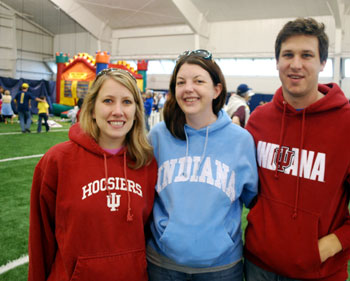
Audra McKinzie, Amy Legg and Kyle Fellerhoff, all '04 graduates of Indiana University, Bloomington. McKinzie is currently a graduate student at UM. From the Small World file: Fellerhoff hails from Columbus, Indiana, the same hometown as Dave Askins, editor of The Chronicle. They have a high school English teacher in common: Shirley Lyster. (Photo by the writer.)
How Forks Are Compostable, and the Hoosier Connection
What makes forks compostable? Well, they’re made from corn. That’s another homecoming connection to Indiana, besides the fact that the Hoosiers were the scheduled opponent on the football field: Indiana ranks fourth – behind Iowa, Illinois, and Nebraska – among states in corn production.
The Chronicle asked three Hoosiers, whose crimson colors were easy to spot in the throng at the UM homecoming tailgate, about the quality of the cutlery. We were curious to know if there were any performance sacrifices that had to be accepted to get the benefit of their compostability.
From Audra McKinzie, Amy Legg and Kyle Fellerhoff, who are all ’04 graduates of IU Bloomington – the answer was that the corn-based cutlery was indistinguishable from regular plasticware. They’d enjoyed their tailgate food unaware there was anything special about the cutlery.
Among the food on offer that needed cutlery to consume was an egg dish called Scrambled “Hoosiers.”
On display at Oosterbaan Fieldhouse for alums to admire was the MRacing vehicle, which was fresh off a fifth-place finish in a field of 78 entries in Formula Student Germany (FSG) competition, which was held Aug. 5-9, 2009 in Germany. The tires sported the word “Hoosier” – they were sourced from Hoosier Racing Tire Corp. in Indiana.
For the football game, there was one potential conflict in loyalties among the Student Sustainability Initiative volunteers that proved unfounded. While Julia Koslow grew up in Indianapolis, she didn’t go to school at Indiana University. It was the previous week when her loyalty had been tested – she’s a Notre Dame grad.
Who Are the Students in SSI?
If The Chronicle couldn’t expose Koslow as a Hoosier fan, could we perhaps challenge her composting credentials? We asked her if she composted at home. Yes. In her apartment. How do you compost if you don’t have a backyard? You do it with worms. She explained that she’d inherited the composting bin, with its separate chamber for the worms, from a student who’d already graduated. Finding a place to put the castings [worm crud] was a challenge, she reported, but they can be tossed pretty much anywhere outside.

Standing are Mark Ellis and Julia Koslow. Kneeling, writing the word "Trash" on the yellow box, is Elizabeth Senecal. (Photo by the writer.)
Staffing the same station as Koslow was Elizabeth Senecal. Senecal served two years in the Peace Corps before embarking on her studies at UM. Part of her work in sustainable agriculture – living in a Senegalese village of 900 people with no electricity or running water – was to convert a “dead fencing” system to a live one. The fence in question runs about one kilometer around a garden plot tended by the village’s women. Its function is to keep the animals out of the garden.
Historically, women have gathered dead branches, corn stalks, and other materials to build the “dead fence” anew after rainstorms wash it away. The vertical elements of the live fence are made up of trees that are planted an appropriate distance apart. The spaces between the trees can be filled in with material taken from the trees themselves – which saves the effort of scavenging over vast distances.
Phillip and Alex, who staffed a waste station on the opposite side of Oosterbaan Fieldhouse from Elizabeth and Julia, are two guys with no particular background as artists, but who are undaunted by their adopted project of creating art out of some of the plastic cups they were accumulating.
The art project was more or less an “audible called at the line of scrimmage” when some orange juice cups they thought would be accepted nicely into the plastics recycling bin failed on grounds of their shape. They need to have a neck to be accepted – it’s not clear why.
Tom Brokaw
Tom Brokaw, when spotted in the wild at Oosterbaan Fieldhouse, was not immediately recognizable as Tom Brokaw. Once people began to ask, “Is that guy Tom Brokaw?” the resemblance was easier to spot. He was taping material for an upcoming MSNBC documentary on baby boomers.
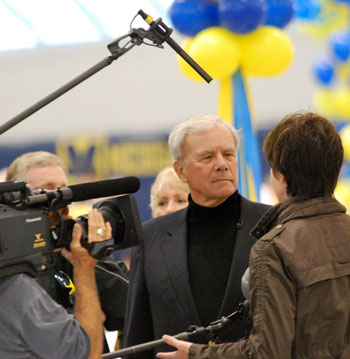
Tom Brokaw interviewing baby boomers for an upcoming MSNBC documentary about the impact of the poor economy on baby boomers. (Photo by the writer.)
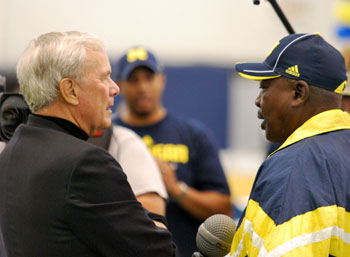
Tom Brokaw interviewing Jesse Rawls, Sr. a 1971 graduate of UM. Rawls' two sons graduated UM in '96 and '01. His daughter graduated in '95. (Photo by the writer.)
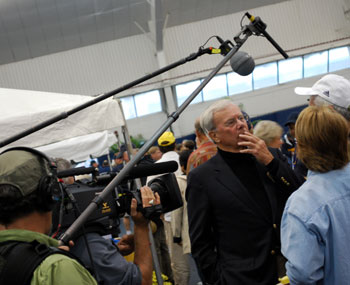
Tom Brokaw was not saying, "You've got some scrambled eggs stuck on your upper lip ... no, a little to the left ... more ... okay, you got it." (Photo by the writer.)
Pure University of Michigan
The UM Alumni Association Tailgate at Oosterbaan was pure University of Michigan, with all the trimmings.
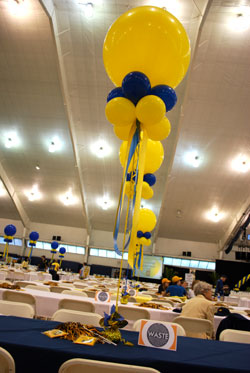
Maize and blue balloon bouquets adorned the tables, along with the Zero Waste table tents. (Photo by the writer.)
Refuse Items
SSI students contended with a range of refuse. Here’s a sampling:




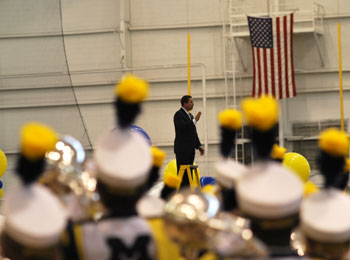
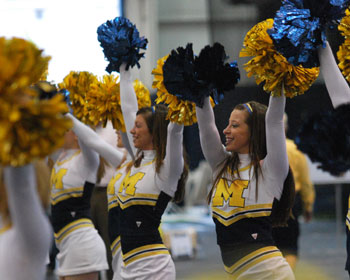
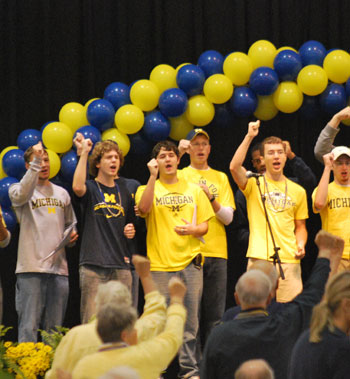

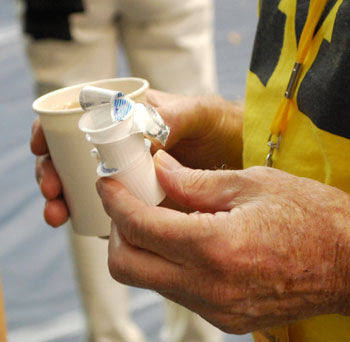
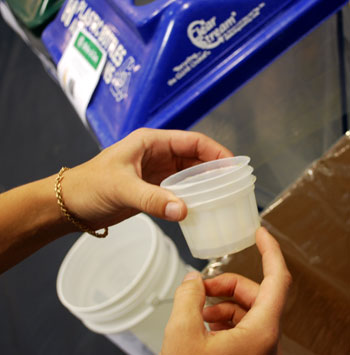
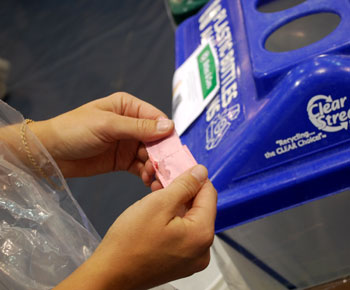
Great story! I’m so excited to see progress being made on waste management at UM. I did some work at the Union when I was an undergrad (about 1994). Some other students and I sorted trash (yes, it was really gross!) in the Union ballroom and determined that food was the largest component of waste. We couldn’t convince anyone to start a compost program back then. Paper was the next target. We tried a campaign to get people to put their paper Wendy’s bags into the recycling bins instead of the trash … but unfortunately, I don’t think we were very successful.
A few years after this, when I was a grad student teaching assistant – I conducted a similar waste project with some undergrads at Chrisler (the group of students included then UM superstar Maceo Baston). We determined the plastic cups were the biggest problem in the waste stream. I wonder if they’ve done anything about this since then?